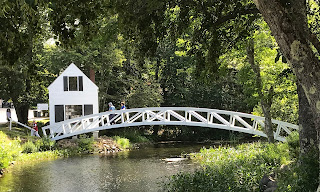 |
| Monday morning |
Road Scholar was the ideal way to get the most out of our visit. 3.5 million people visited Acadia in 2017 and there will be more this year. Our program was organized by Glenn Tucker, who's been a Road Scholar provider for more than 20 years. There were 23 people in our group, the maximum size for the small tour bus. Participants were mostly from the east coast. (A woman from Wisconsin and we were the farthest west.)
Humans have lived on Mt. Desert for 5,000 years. In 1604 Samuel de Champlain was the first European to document MDI. The French and British disputed ownership (they wanted the rich fishing grounds). English colonists established a permanent settlement in 1761. The town of Eden, later called Bar Harbor, was created in 1796.
The rise of tourism and "re-creation" in the mid-19th century brought artists and wealthy city dwellers from Boston, New York, and Philadelphia. The "rusticators" stayed in huge hotels or built elaborate summer "cottages." Land preservation began in 1901 when summer residents Charles Eliot (president of Harvard), George Dorr (heir to a Boston textile fortune), and John D. Rockefeller Jr. acquired (by donation) 5,000+ acres. They presented it to the federal government -- the only national park that was given, not purchased.
 |
| View from Cadillac Mountain |
We began with a after-dinner walking tour of Victorian Bar Harbor. In 1946 a tremendous fire devastated the town and most of the island so much that's downtown is relatively new.
Monday: into the national park, where we saw the remnants of George Dorr's family home, Old Farm.At the YWCA we learned about the flora and fauna of Mt. Desert from Ruth Grierson, who's *only* 90 (and sharp!). Historian Tim Garrity told us about historical fiction and fact on MDI. After lunch we drove into the park along Ocean Drive where we saw Thunder Hole fill and spray, fill and spray. We went up Cadillac Mountain, the highest elevation on the eastern seaboard.

We learned about lobsters. Maine lobstermen (who are women, too) are in the forefront of conservation with strict rules about what they can keep and what they can release. Consider: 200 years ago lobstering was for old men and young boys who could just walk out along the beach and harvest all the lobster they could eat (and prisoners at the York Co. jail protested because all they got was lobster),
We went to the Maine Granite Industry Museum. Founder Steve Haynes has amassed tools, papers, books, and oral histories about all the quarries on the island and inland. Maine granite was used in buildings as far west as Omaha.

 This is why we enjoy Road Scholar -- we would not have found this museum ourselves.
This is why we enjoy Road Scholar -- we would not have found this museum ourselves. We also had a hand in splitting a rock. It happened to be my turn when the rock split, right along the line created by the wedges.
It was foggy for our three-hour (really!) bay tour. The boat docked at Little Cranberry Island for an hour so we could walk around.
 |
| The ospreys live in Apt. 2A |

 And, yes, there's a quilt shop in Bar Harbor. I paid a visit to Fabricate and chatted with the owner. Nessa is a Bowdoin alumna. In conversation, it turned out that she is one of my husband's fraternity brothers! (Bowdoin made all the fraternities go co-educational. All members are "brothers," regardless of gender. In 2000 the college closed the entire system.) I went back to the hotel to fetch Stevens. He said he'd never kissed an AD brother.
And, yes, there's a quilt shop in Bar Harbor. I paid a visit to Fabricate and chatted with the owner. Nessa is a Bowdoin alumna. In conversation, it turned out that she is one of my husband's fraternity brothers! (Bowdoin made all the fraternities go co-educational. All members are "brothers," regardless of gender. In 2000 the college closed the entire system.) I went back to the hotel to fetch Stevens. He said he'd never kissed an AD brother. Fabricate has a great selection, including a lot of Maine-themed novelties such as six different blueberry prints, lots of lobsters, gulls, and puffins. My favorite (yes, I bought some) is a print with beach glass.

Road Scholar concluded at lunchtime on Thursday.
Here's our group in front of the tour bus.
Here are a few more photos.
It is legal to pick blueberries in the national park. There is a limit of one pint per person per year. (No explanation of how that's monitored.)
 |
| Somesville |

 |
| bunchberry |
 |
| no beach glass but lots of mussel shells |
 |
| Jordan Pond |
There is a bald eagle in the middle of the photo.
Three maple species: striped, red, sugar.
The size of the striped maple leave led to the name "poor man's toilet paper."
 Carriage road gatehouse. Looks like a structure in a Thomas Kinkade painting.
Carriage road gatehouse. Looks like a structure in a Thomas Kinkade painting.All that is left of George Dorr's Old Farm "cottage." The woods reclaimed the site long ago.















love seeing that pink granite again nann...i swiped a small piece from cadillac mt when i visited acadia....so beautiful
ReplyDelete